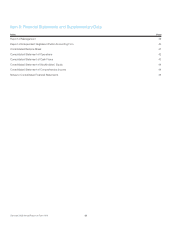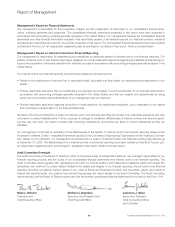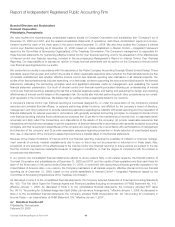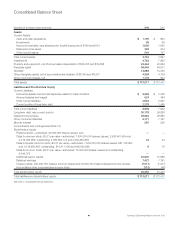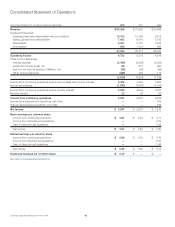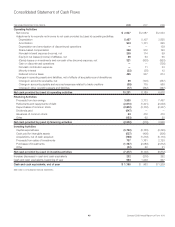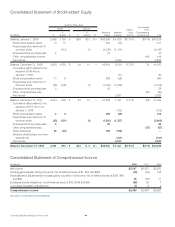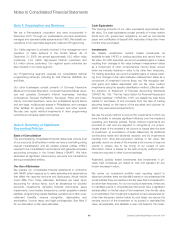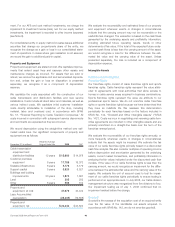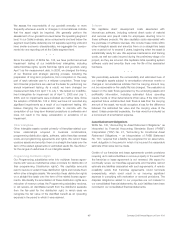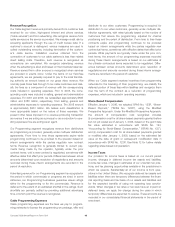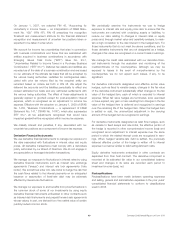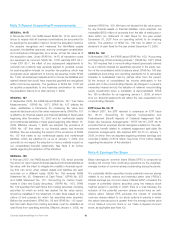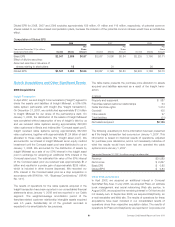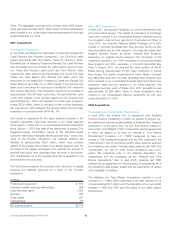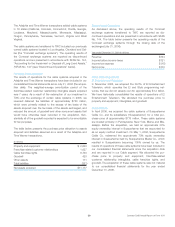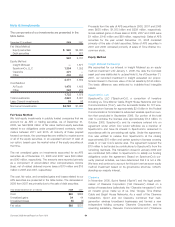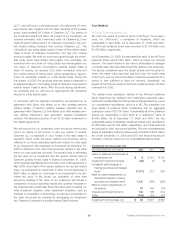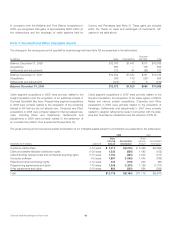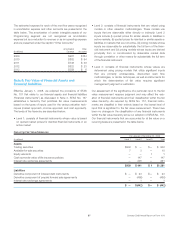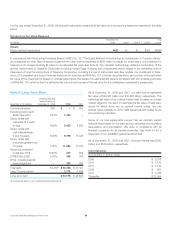Comcast 2008 Annual Report Download - page 50
Download and view the complete annual report
Please find page 50 of the 2008 Comcast annual report below. You can navigate through the pages in the report by either clicking on the pages listed below, or by using the keyword search tool below to find specific information within the annual report.Revenue Recognition
Our Cable segment revenue is primarily derived from customer fees
received for our video, high-speed Internet and phone services
(“cable services”) and from advertising. We recognize revenue from
cable services as the service is provided. We manage credit risk by
screening applicants through the use of credit bureau data. If a
customer’s account is delinquent, various measures are used to
collect outstanding amounts, including termination of the custom-
er’s cable service. Installation revenue obtained from the
connection of customers to our cable systems is less than related
direct selling costs. Therefore, such revenue is recognized as
connections are completed. We recognize advertising revenue
when the advertising is aired and based on the broadcast calendar.
Revenue earned from other sources is recognized when services
are provided or events occur. Under the terms of our franchise
agreements, we are generally required to pay to the local franchis-
ing authority an amount based on our gross video revenue. We
normally pass these fees through to our cable customers and clas-
sify the fees as a component of revenue with the corresponding
costs included in operating expenses. Prior to 2008, the corre-
sponding costs were included in selling, general and administrative
expenses. For 2007 and 2006, we reclassified approximately $863
million and $788 million, respectively, from selling, general and
administrative expenses to operating expenses. The 2008 amount
is approximately $933 million. We believe such classification is
more appropriate based on the nature of these expenses. We
present other taxes imposed on a revenue-producing transaction
as revenue if we are acting as a principal or as a reduction to oper-
ating expenses if we are acting as an agent.
Our Programming segment recognizes revenue from distributors
as programming is provided, generally under multiyear distribution
agreements. From time to time these agreements expire while
programming continues to be provided to the operator based on
interim arrangements while the parties negotiate new contract
terms. Revenue recognition is generally limited to current pay-
ments being made by the operator, typically under the prior
contract terms, until a new contract is negotiated, sometimes with
effective dates that affect prior periods. Differences between actual
amounts determined upon resolution of negotiations and amounts
recorded during these interim arrangements are recorded in the
period of resolution.
Advertising revenue for our Programming segment is recognized in
the period in which commercials or programs are aired. In some
instances, our Programming businesses guarantee viewer ratings
either for the programming or for the commercials. Revenue is
deferred to the extent of an estimated shortfall in the ratings. Such
shortfalls are primarily settled by providing additional advertising
time, at which point the revenue is recognized.
Cable Programming Expenses
Cable programming expenses are the fees we pay to program-
ming networks to license the programming we package, offer and
distribute to our video customers. Programming is acquired for
distribution to our video customers, generally under multiyear dis-
tribution agreements, with rates typically based on the number of
customers that receive the programming, adjusted for channel
positioning and the extent of distribution. From time to time these
contracts expire and programming continues to be provided
based on interim arrangements while the parties negotiate new
contractual terms, sometimes with effective dates that affect prior
periods. While payments are typically made under the prior con-
tract terms, the amount of our programming expenses recorded
during these interim arrangements is based on our estimates of
the ultimate contractual terms expected to be negotiated. Differ-
ences between actual amounts determined upon resolution of
negotiations and amounts recorded during these interim arrange-
ments are recorded in the period of resolution.
When our Cable segment receives incentives from programming
networks for the licensing of their programming, we classify the
deferred portion of these fees within liabilities and recognize them
over the term of the contract as a reduction of programming
expenses, which are included in operating expenses.
Share-Based Compensation
Effective January 1, 2006, we adopted SFAS No. 123R, “Share-
Based Payment,” (“SFAS No. 123R”), using the Modified
Prospective Approach. Under the Modified Prospective Approach,
the amount of compensation cost recognized includes
(i) compensation cost for all share-based payments granted before
but not yet vested as of January 1, 2006, based on the grant date
fair value estimated in accordance with SFAS No. 123,
“Accounting for Stock-Based Compensation,” (“SFAS No. 123”),
and (ii) compensation cost for all share-based payments granted
or modified after January 1, 2006, based on the estimated fair
value at the date of grant or subsequent modification date in
accordance with SFAS No. 123R. See Note 12 for further details
regarding share-based compensation.
Income Taxes
Our provision for income taxes is based on our current period
income, changes in deferred income tax assets and liabilities,
income tax rates, changes in estimates of our uncertain tax posi-
tions, and tax planning opportunities available in the jurisdictions in
which we operate. Substantially all of our income is from oper-
ations in the United States. We recognize deferred tax assets and
liabilities when there are temporary differences between the finan-
cial reporting basis and tax basis of our assets and liabilities and
for the expected benefits of using net operating loss carryfor-
wards. When changes in tax rates or tax laws have an impact on
deferred taxes, we apply the change during the years in which
temporary differences are expected to reverse. These amounts are
recorded in our consolidated financial statements in the period of
enactment.
Comcast 2008 Annual Report on Form 10-K 48


